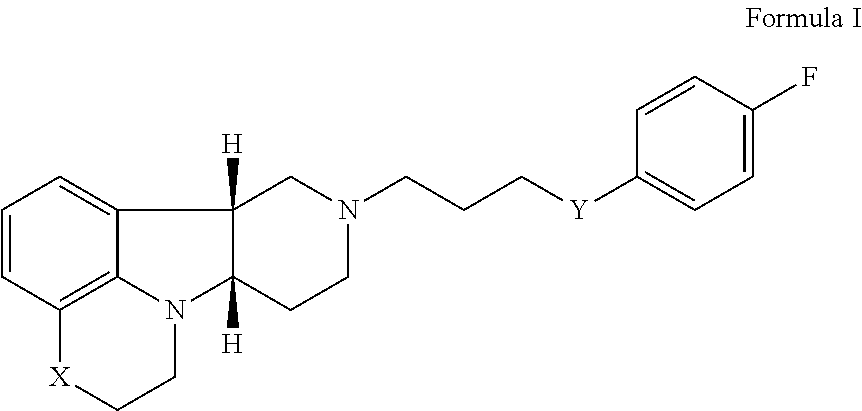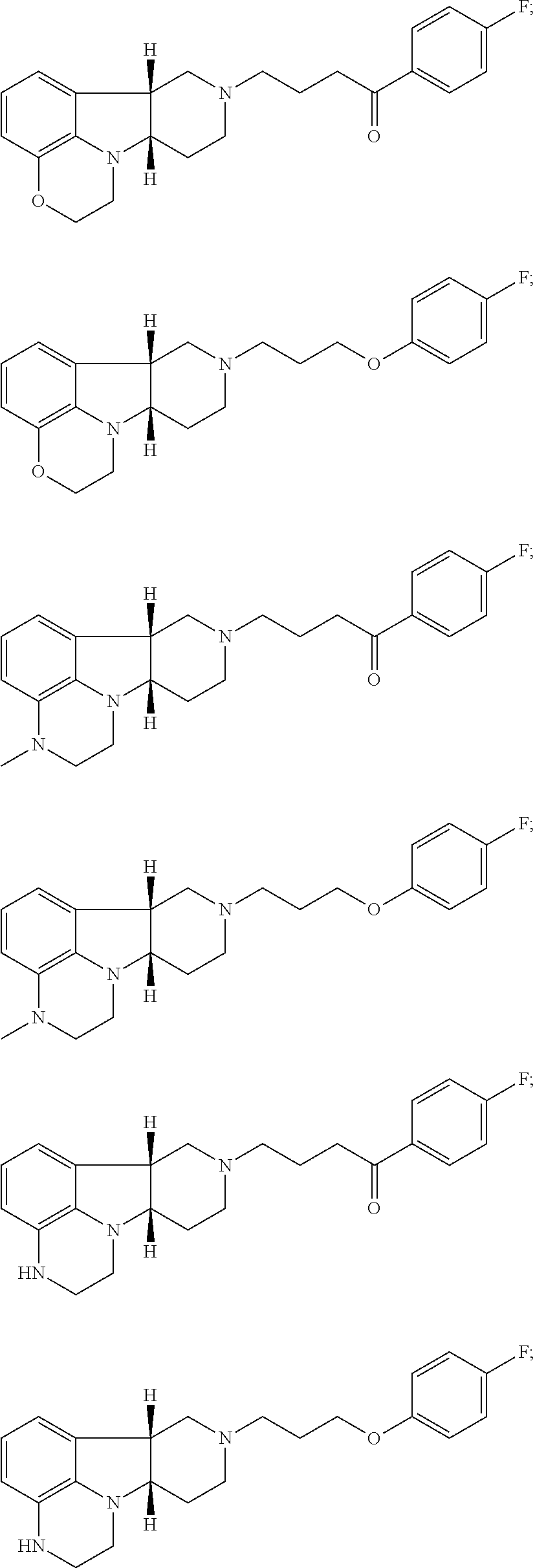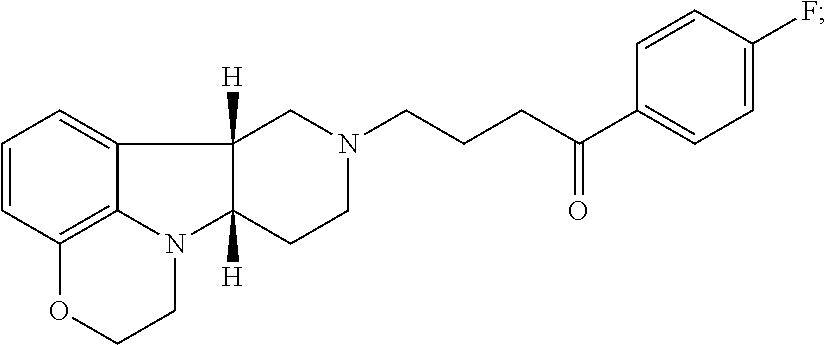Methods and compositions for sleep disorders and other disorders
a technology of sleep disorders and compositions, applied in the field of sleep disorders and other disorders, can solve the problems of acute dystonia, tardive dyskinesia may persist, short-term and long-term movement disorders and other side effects, etc., to improve sleep maintenance insomnia and insomnia, increase slow wave sleep, and improve sleep maintenance. and insomnia and other problems
- Summary
- Abstract
- Description
- Claims
- Application Information
AI Technical Summary
Benefits of technology
Problems solved by technology
Method used
Image
Examples
example 1
Binding Assay for 5-HT2A, Dopamine D2, SERT, αA1, 5-HT2C and H1 Receptors
[0180]Binding studies for 5-HT2A, dopamine D2, SERT, αA1, 5-HT2C and H1 receptors are well known in the art and may be used to determine the binding affinities of the Compounds of the Invention. A Compound of Formula I, 1-(4-Fluoro-phenyl)-4-((6bR,10aS)-3-methyl-2,3,6b,9,10,10a-hexahydro-1H,7H-pyrido[3′,4′,4,5]pyrrolo[1,2,3-de]quinoxalin-8-yl)-butan-1-one (Compound A) is selected for detailed evaluation. The compound exhibits binding affinity profiles for 5-HT2A, D2, SERT, αA1, 5-HT2C and H1 as disclosed in Table 1 and Table 2 compared to known antipsychotic agents.
[0181]A representative method for performing the binding studies may be found in Fitzgerald et al., J. Neurochem. 1999 May; 72(5): 2127-34, the disclosure of which is incorporated by reference.
[0182]1-(4-[125I]iodo-2,5-dimethxoyphenyl)-2-aminopropane([125]DOI; 2, 200 Ci / mmol), N-[3H]methylspiperone (50 Ci / mmol), [3H]Prazosin (77 Ci / mmol), and lysergi...
example 2
Effectiveness of the Compounds of Formula I as Antidepressant in Chronic Animal Model of Depression
[0195]Experimental procedure for Table II:
[0196]Two different assays used to characterize affinity for the serotonin transporter were conducted at Caliper Life Sciences (Hopkinton, Mass.), a company that acquired NovaScreen. One assay (#100-0056), Transporter SERT, was a radioligand binding assay in rat forebrain using [3H]-N-Methyl-Citalopram as the radioligand at a concentration of 0.7 nM. [3H]-N-Methyl-Citalopram has a Kd (binding affinity) of 1.7 n and a Bmax of 33.1 fmol / mg protein, The assay was validated using the following reference agent, imipramine (IMI) (Ki=40.9 nM). Other reference agents which may be used include paroxetine (Ki=0.1 nM); fluoxetine (Ki=1.4 nM); clomipramine (Ki=2.8 nM), serotonin (Ki=55.6 nM), and zimeldine (Ki=68.3 nM).
[0197]The other assay, Transporter SERT (h) was a radioligand binding assay in human platelets using [3H]-N-Methyl-Citalopram as a radiolig...
example 3
Effectiveness in Alleviating L-Dopa Induced Dyskinesia
[0204]Reduction in axial, orolingual and limb abnormal involuntary movements using standard Abnormal Involuntary Movement Scale (AIMS) in dyskinesic mice injected daily with the compound in combination with L-DOPA indicates that co-administration of Compounds of Formula I reduces development and expression of AIMS associated with dyskinetic behavior (orolingual, axial, and limb) and locomotor activity (locomotive AIMS). Unilateral 6-OHDA-lesioned mice are administered a Compound of Formula I (Compound A) in accordance with the following schedule:
[0205]Control:
[0206]Day 1-Day 9: Treatment with L-DOPA / benserazide
[0207]Day 10: Treatment with L-DOPA / benserazide+Evaluation of AIMs (dyskinesia)
[0208]Experiment 1 (Chronic): Development of Dyskinesia
[0209]Day 1-Day 10: Treatment with L-DOPA / benserazide plus ITI-007 ITI-007PD.
[0210]Day 11: Treatment with L-DOPA / benserazide+Evaluation of AIMs (dyskinesia)
[0211]Experiment 2 (Acute): Express...
PUM
| Property | Measurement | Unit |
|---|---|---|
| disorder | aaaaa | aaaaa |
| structure | aaaaa | aaaaa |
| binding affinity | aaaaa | aaaaa |
Abstract
Description
Claims
Application Information
 Login to View More
Login to View More - R&D
- Intellectual Property
- Life Sciences
- Materials
- Tech Scout
- Unparalleled Data Quality
- Higher Quality Content
- 60% Fewer Hallucinations
Browse by: Latest US Patents, China's latest patents, Technical Efficacy Thesaurus, Application Domain, Technology Topic, Popular Technical Reports.
© 2025 PatSnap. All rights reserved.Legal|Privacy policy|Modern Slavery Act Transparency Statement|Sitemap|About US| Contact US: help@patsnap.com



